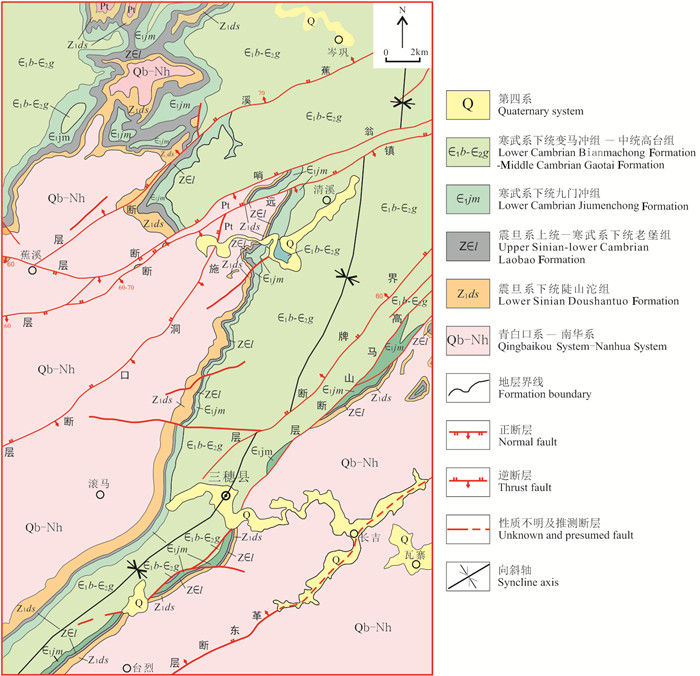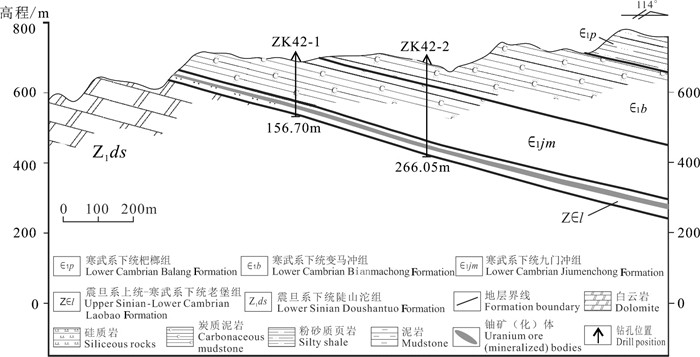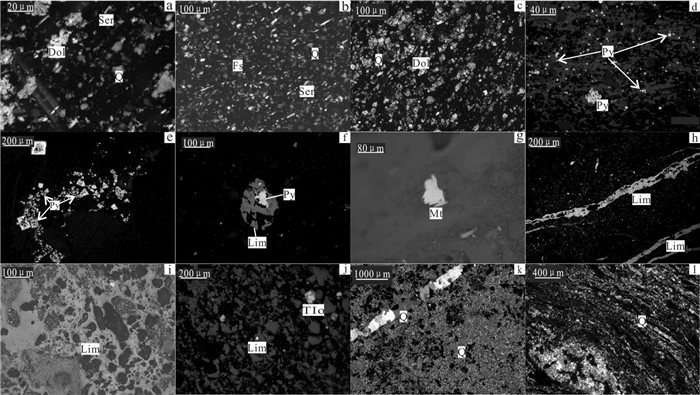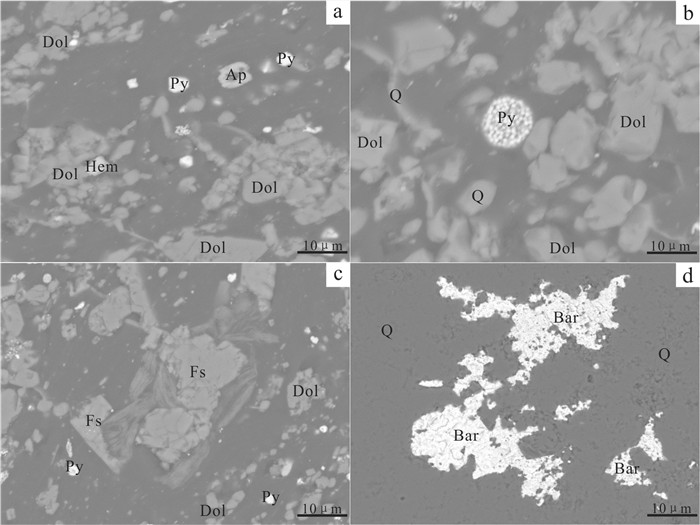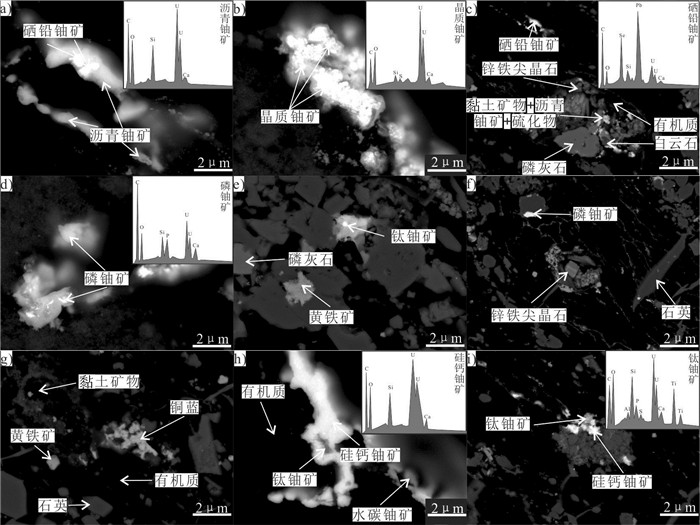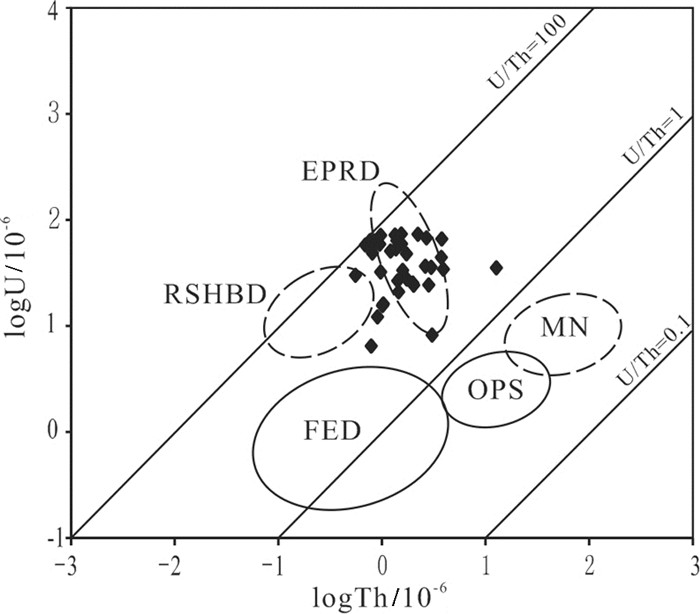Ore mineralogical characteristics of Sansui uranium deposit in Guizhou Province, China and indication for prospecting
-
摘要:
三穗铀矿床位于黔中—湘西北铀成矿带内,产于震旦—寒武系老堡组炭质泥岩中,是贵州省近年勘查发现的第一个大型铀矿床。
研究目的 鉴于黔东地区铀矿成矿规律、富集机理及矿石矿物学等研究程度低,查明典型铀矿床矿石矿物组合及化学组分,探讨成矿环境,揭示成矿过程,深化成矿理论认识,将为促进区域成矿预测、扩大找矿勘查成果及丰富该类型铀矿成矿理论提供科学依据。
研究方法 基于三穗铀矿床地质、地球化学特征,通过电子探针、扫描电镜等测试,分析了铀成矿机理及成岩成矿的环境演化。
研究结果 本区含铀岩系老堡组形成于震旦纪/寒武纪转折期的陆缘裂谷和陆缘裂陷缺氧还原环境,铀成矿初始物源与海底火山活动有关;铀矿石主要由铀矿物、铁矿物、黏土矿物、有机质及白云石、石英(或玉髓)、重晶石、方解石等组成,呈微晶—隐晶结构、微晶—粉晶晶粒状结构,层状、纹层状构造;铀矿物丰富,主要有沥青铀矿、硅钙铀矿、硒铅铀矿、钛铀矿、磷铀矿及水碳铀等,以纳米—微米级粒状、柱状(粒径多 < 10 μm)、细脉状、或隐晶质形式赋存于有机质、铁质、黏土矿物等聚铀矿物中。
结论 三穗铀矿床形成物源具有多源性,与雪峰期海底火山作用带来部分成矿物质、燕山—喜马拉雅期成矿流体在运移的途中不断浸取地层内的成矿物质密切相关,经历了铀初始富集、氧化淋滤及热液叠加再富集过程,成因属典型的碳硅泥岩型。三穗铀矿床中发现大量铀矿物显示,铀富集程度高、成矿作用强,找矿远景好、潜力大。
Abstract:This paper is the result of mineral exploration engineering.
The Sansui deposit is located in the uranium metallogenic belt between central Guizhou and northwest Hunan Province. It is the first large uranium deposit discovered in Guizhou Province in recent years. The uranium deposit situates in the carbonaceous mudstone of Laobao Formation of Sinian - Cambrian and is stratified and like stratified.
Objective The purpose of this paper is to find out the ore and mineral composition of Sansui uranium deposit, explore the uranium mineralization environment, reveal the mineralization process of uranium initial enrichment, leaching, superposition and re-enrichment, and provide new information for regional metallogenic prediction, ore exploration and enrichment of this type of uranium ore-forming theory.
Methods The study on mineral mineralogy and geological characteristics of ore deposits shows that
Results (1) The Laobao Formation of uranium-bearing rocks was formed in the anoxic reduction environment of the continental margin rift and continental margin rifting during the Sinian/Cambrian transitional period. (2) The uranium ore is mainly composed of uranium mineral, iron ore, clay mineral, organic matter, dolomite, quartz (or chalcedite), barite, calcite, etc., with microcrystal-cryptocrystal structure, microcrystal-powder grain structure, layered and lamellar structure. (3) The uranium ore is rich in uranium minerals, mainly pitchblende, silica-calcined uranium ore, selenium-lead uranium ore, titanium-uranium ore, phosphorus uranium ore and water-carbon uranium, etc. They occur in the form of nano-micron granule, column (particle size < 10 microns), veinlet, or in the form of cryptocrystalline occurrence in the organic matter, iron, clay minerals and other uranium minerals. (4) The constant element in the ore were enriched in SiO2, CaO and LOI (burning loss), which was consistent with the rich silica, calcium and organic minerals.
Conclusions The uranium source of the Sansui deposit was related to the submarine volcanic eruption, spillage during the Xuefeng period and the weathering and leaching of uranium-bearing geological bodies. Mineralization and its associated trace elements such as U, V, Mo, Cd, Se, Ni, Zn, etc. are significantly enriched, which is related to the fact that some ore-forming materials and ore-forming fluids are continuously leaching ore-forming materials in the strata during the process of submarine volcanic eruption and spill.
-

-
图 1 贵州东部地质矿产略图(据陶平等,2009修编)
Figure 1.
图 7 三穗铀矿床围岩U-Th图解(据Bostrorn,1983)
Figure 7.
表 1 三穗铀矿床主要常量元素分析结果(%)
Table 1. Analysis results of constant element in Sansui uranium deposit (%)

表 2 三穗铀矿床微量元素分析结果(10-6)
Table 2. Analysis results of trace element in Sansui uranium deposit (10-6)

表 3 三穗铀矿床矿石矿物组成
Table 3. Mineral composition of ore in Sansui uranium deposit

-
Algeo T J, Maynard J B. 2004. Trace-element behavior and redox facies in core shale of upper Pennsylvanian Kansas-type cyclothems[J]. Chemical Geology, 206(3): 289-318. http://homepages.uc.edu/~algeot/Algeo-Maynard-ChemGeol-2004.pdf
Bostrom K. 1983. Genesis of ferromanganese deposits-diagnostic criteria for recent and old deposits[C]//Rona P A(ed. ). Hydrothermal Processes at Seafloors Spreading Centers. New York: Plenum Press, 473-489.
Bostrom K, Rydell H, Joensuu O. 1973. Langban-an exhalative sedimentary deposits[J]. Economic Geology, 74(5): 1002-1011. http://www.onacademic.com/detail/journal_1000039022206110_d4b2.html
Bostrom K, Peterson M N A. 1969. The origin of aluminum-poor ferromanganese sediments in areas of high heart flow on the West Pacific Rise[J]. Marine Geology, 7: 427-447. doi: 10.1016/0025-3227(69)90016-4
Cai Yuqi, Zhang Jindai, Li Ziying, Guo Qingying, Song Jiye, Fan Honghai, Liu Wusheng, Qi Fucheng, Zhang Minglin. 2015. Outline of uranium resources characteristics and metallogenetic regularity in China[J]. Acta Geologica Sinica, 89(6): 1051-1069(in Chinese with English abstract). http://www.cnki.com.cn/Article/CJFDTotal-DZXW201503021.htm
Cai Yuwen, Wang Huajian, Wang Xiaomei, He Kun, Zhang Shuichang, Wu Chaodong. 2017. Formation conditions and main controlling factors of uranium in marine source rocks[J]. Advances in Earth Science, 32(2): 199-208 (in Chinese with English abstract). http://en.cnki.com.cn/Article_en/CJFDTOTAL-DXJZ201702010.htm
Chen Lulu, Chen Yin, Guo Hu, Feng Xiaoxi, Li Jianguo, Tang Chao, Zhao Hualei. 2018. Alteration characteristics of titanium-bearing minerals and new knowledge about their relationship to uranium occurrence in uraniferous sandstone of Nalinggou area, Ordos Basin[J]. Geology in China, 45(2): 408-409 (in Chinese with English abstract).
Douthitt C B. 1982. The geochemistry of the stable isotopes of silicon[J]. Geochimica et Cosmochimica Acta, 46(8): 1449-1458. doi: 10.1016/0016-7037(82)90278-2
Dou Xiaoping, Xiong Chao, Zeng Wenle, Wu Zhanhua. 2015. Mineralization features and controlling factors of Dongkeng uranium deposit in the northwest of Jiangxi province[J]. World Nuclear Geoscience, 32(4): 192-199 (in Chinese with English abstract). http://en.cnki.com.cn/Article_en/CJFDTOTAL-GWYD201504002.htm
Du Letian. 2014. Hydrogen geochemistry: Hydride migration law of hacons[J]. Uranium Geology, 30(2): 65-77 (in Chinese with English abstract). http://en.cnki.com.cn/Article_en/CJFDTOTAL-YKDZ201402001.htm
Du Letian, Wang Yuming. 1984. Uniform metallogenic mechanism among the granite, volcanic, carbonaceous-siliceous-pelitic rock and sandstone-hosted uranium deposits in south China[J]. Radioactive Geology, (3): 1-10(in (Chinese with English abstract). http://www.researchgate.net/publication/288906008_Uniform_metallogenic_mechanism_among_the_granite-_volcanic-_carbonaceous-siliceous-pelitic_rock_and_sand-stone-hosted_uranium_deposits_in_South_China_J
Gao Changlin, He Jiangqi. 1999. The geochemical features and genesis of the silicalite in Beidabashan[J]. Earth Science——Journal of China University of Geosciences, 24(3): 246-249 (in Chinese with English abstract).
Guizhou Geological Survey. 2017. The Regional Geology of China, Guizhou Province[M]. Beijing: Geological Publishing House, 1-1098 (in Chinese).
Guo Baochi, Zhang Daishi, Li Shengxiang, Zhu Jiechen. 1995. Genesis of the carbonate-siliceous-pelitic type uranium deposits in Baoyuan area[J]. Uranium Geology, 11(5): 266-272 (in Chinese with English abstract).
Hitzman M W. 2003. Classification, genesis, and exploration guides for nonsulfide zinc deposits[J]. Economic Geology, 98(4): 685-714. doi: 10.2113/gsecongeo.98.4.685
Hu Ruizhong, Fu Shanling, Huang Yong, Zhou Meifu, Fu Shaohong, Zhao Chenghai, Wang Yuejun, Bi Xianwu, Xiao Jiafei. 2017. The giant South China Mesozoic low-temperature metallogenic domain: Review and a new geodynamic model[J]. Journal of Asian Earth Sciences, 37: 9-34.
Hu Ruizhong, Fu Shanling, Xiao Jiafei. 2016. Major scientific problems on low-temperature metallogenesis in south China[J]. Acta Petrologica Sinica, 32(11): 3239-3251(in Chinese with English abstract).
Hu Ruizhong, Zhou Mingfu. 2012. Multiple Mesozoic mineralization events in South China——An introduction to the thematic issue[J]. Mineralium Deposita, 47(6): 579-588. doi: 10.1007/s00126-012-0431-6
Hu Ruizhong, Burnard P G, Bi Xianwu, Zhou Mingfu, Peng Jiantang, Su Wenchao, Zhao Junhong. 2009. Mantle-derived gaseous components in ore-forming fluids of the Xiangshan uranium deposit, Jiangxi Province, China: Evidence from He, Ar and C isotopes[J]. Chemical Geology, 266(1/2): 86-95. http://www.sciencedirect.com/science/article/pii/S0009254108003239
Hu Ruizhong, Bi Xianwu, Zhou Mingfu, Peng Jiantang, Su Wenchao, Liu Shen, Qi Huawen. 2008. Uranium metallogenesis in South China and its relationship to crustal extension during the Cretaceous to Tertiary[J]. Economic Geology, 103(3): 583-598. doi: 10.2113/gsecongeo.103.3.583
Hu Ruizhong, Bi Xianwu, Su Wenchao, Peng Jiantang, Li Chaoyang. 2004. The relationship between uranium metallogenesis and crustal extension during the cretaceous-tertiary in South China[J]. Earth Science Frontiers, 11(1): 153-160(in Chinese with English abstract). http://adsabs.harvard.edu/cgi-bin/nph-data_query?bibcode=2001eag..conf.3522H&db_key=AST&link_type=ABSTRACT
Hu Ruizhong. 1991. Research on the Function and Origin of ∑CO2 in Forming Hydrothermal Uranium Deposits in South China[D]. Guiyang: Institute of Geochemistry, Chinese Academy of Sciences, 1-96(in Chinese with English abstract).
Huang Wenbin, Li Wanlun, Wu Xishun. 2017. Situation of uranium resources [J]. Technology and Industry Across the Straits, (6): 136-138(in Chinese with English abstract).
Jiang Yonghong, Li Shengrong. 2005. A study of the fluid environment of silicalite of transitional Precambrian-Cambrian age in Hunan and Guizhou Provinces[J]. Earth Science Frontiers, 12(4): 622-629 http://www.cnki.com.cn/Article/CJFDTotal-DXQY200504044.htm
Jin Zhongguo, Liu Kaikun, Luo Kai, Zheng Minghong, Yang Shengfa, Li Yantao, Fan Yunfei, Wang Qiong. 2019. Geological geochemical characteristics and genesis of Longwan uranium deposit, Sansui, Guizhou Province[J]. Acta Petrologica Sinica, 35(9): 2830-2844(in Chinese with English abstract). doi: 10.18654/1000-0569/2019.09.14
Li Shengrong, Gao Zhenmin. 1995. REE characteristics of black rock series of the lower Cambrian niutitang formation in Hunan-Guizhou Provinces, Chian with a discussion on the REE patterns in marine hydrothermal sediments[J]. Acta Mineralogica Sinica, 15(2): 225-229(in Chinese with English abstract). http://en.cnki.com.cn/Article_en/CJFDTOTAL-KWXB199502016.htm
Li Yanhe, Duan Chao, Zhao Yue, Pei Haoxiang, Ren Shunli. 2016. The role of oxidizing reducing barrier in mineralization of hydrothermal uranium ore[J]. Acta Geologica Sinica, 90(2): 201-218 (in Chinese with English abstract). http://en.cnki.com.cn/Article_en/ http://search.cnki.net/down/default.aspx?filename=DZXE201602001&dbcode=CJFD&year=2016&dflag=pdfdown
Liu Yingjun, Cao Liming, Li Zhaolin, Wang Henian, Chu Tongqing, Zhang Jingrong. 1986. Geochemistry of Elements[M]. Beijing: Science Press, 1-517 (in Chinese).
Luo Taiyi, Ning Xingxian, Luo Yuanliang, Li Xiaobiao, Lin Rongxiang, Yao linbo. 2005. Super-enrichment of Se in the bottom black shales Lower Cambrian at Zunyi, Guizhou Province, China[J]. Acta Mineralogica Sinica, 25(3): 275-282(in Chinese with Enrlish abstract). http://en.cnki.com.cn/Article_en/CJFDTOTAL-KWXB200503011.htm
Massey M S, Lezama-Pacheco J S, Jones M E, Ilton E S, Cerrato José M and Bargar J R. 2014. Competing retention pathways of uranium upon reaction with Fe (II)[J]. Geochimica et Cosmochimica Acta, 142(1): 166-185. http://www.onacademic.com/detail/journal_1000036714819910_1220.html
Min Maozhong, Zhang Fusheng. 1992. Introduction Causes of Uranium Mineralogy [M]. Beijing: Atomic Energy Press, 1-264(in Chinese).
Mou Baolei. 1992. Geochemistry of Elements[M]. Beijing: Peking University Press, 1-125 (in Chinese).
Peng Jun, Tian Jingchun, Yi Haisheng, Xia Wenjie. 2000. The Late Precambrian hot water sedimentation of the Southeast Yangtze Plate continental margin[J]. Acta Sedimentologica Sinica, 18(1): 107-113(in Chinese with English abstract) http://en.cnki.com.cn/Article_en/CJFDTOTAL-CJXB200001017.htm
Pi Daohui, Liu Congqiang, Shields-Zhou Graham Anthony, Jiang Shaoyong. 2013. Trace and rare earth element geochemistry of black shale and kerogen in the Early Cambrian Niutitang Formation in Guizhou Province, South China: Constraints for redox environments and origin of metals[J]. Precambrian Research, 225(1) : 218-229. http://www.sciencedirect.com/science/article/pii/S0301926811001392
Qi Fucheng, Li Zhixing, Zhang Zilong, Wang Wenquan, Yang Zhiqiang, Zhang Yan. 2015. Hydrothermal decarburization and uranium-polymetallic ore-mineralization in marine phosphorite, northwestern Hunan[J]. Earth Science Frontiers, 22(4): 188-199 (in Chinese with English abstract). http://www.researchgate.net/publication/285429857_Hydrothermal_decarburization_and_uranium-polymetallic_ore-mineralization_in_marine_phosphorite_northwestern_Hunan
Qi Fucheng, Li Zhixing, Zhang Zilong, Wang Wenquan, Wang Wenguang, Yang Zhiqiang, Zhang Yan. 2014. The discovery of onofrite and uraninite in marine phosphorite and its geological significance, northwestern Hunan[J]. Uranium Geology, 30(3): 129-134, 167 (in Chinese with English abstract). http://en.cnki.com.cn/Article_en/CJFDTOTAL-YKDZ201403001.htm
Qi Fucheng, Zhang Zilong, Li Zhixing, Wang Wenquan, Yang Zhiqiang, Zhang Yan, Ma Yu. 2012. Unconventional uranium resources in black rock series in China and its development prospect[J]. World Nuclear Geoscience, 29(4): 187-191, 198(in Chinese with English abstract). http://en.cnki.com.cn/Article_en/CJFDTOTAL-GWYD201204004.htm
Qi Fucheng, Zhang Zilong, He Zhongbo, Li Zhixing, Wang Wenquan, Su Xiangli, Zhang Chao. 2011. Uranium-polymetallic ore-forming system and mechanism of the black rock series in the southeast continental margin of Yangtze plate[J]. Uranium Geology, 27(3): 129-135, 145(in Chinese with English abstract). http://en.cnki.com.cn/Article_en/CJFDTOTAL-YKDZ201103001.htm
Rawat T P S, Josh G B, Bhaskar Basu, Nurul Absar. 2010. Occurrence of proterozoic black shale-hosted uranium mineralisation in Tal Group, Sirmour district, Himachal Pradesh[J]. Journal of the Geological Society of India, 75: 709-714. doi: 10.1007/s12594-010-0057-1
Rudnick R L, Gao Shao. 2003. Composition of the continental crust[J]. Elsevier-Pergamon, Oxford. 3: 1-64.
Scott T B, Allen G C, Heard P J, Randell M G. 2005. Reduction of u(vi) to u(iv) on the surface of magnetite[J]. Geochimica et Cosmochimica Acta, 69(24), 5639-5646. doi: 10.1016/j.gca.2005.07.003
Shi Chunhua, Cao Jian, Hu Kai, Han Shanchu, Bian Lizeng, Yao Suping. 2011. A review on origin of Ni-Mo polymetallic deposits in Lower Cambrian black rock series in South China [J]. Geological Review, 57(5): 6718-6730(in Chinese with English abstract). http://en.cnki.com.cn/Article_en/CJFDTOTAL-DZLP201105014.htm
Sleep N H. 1990. Hotspots and mantle plumes: Some phenomenology[J]. Journal of Geophysical Research: Solid Earth, 95(B5): 6715-6736. doi: 10.1029/JB095iB05p06715
Song Chuanzhong, Li Jianhao, Yan Jiayong, Wang Yangyang, Liu Zhendong, Yuan Fang, Li Zhenwei. 2019. A ten-tative discussion on some tectonic problems in the east of South China continent [J]. Geology in China, 46(4): 704-722(in Chinese with English abstract). http://en.cnki.com.cn/Article_en/CJFDTotal-DIZI201904004.htm
Tao Ping, Xiao Xuedong, Zhang Hui. 2009. The Au-bearing sedimentary sequences and their impact on the gold deposits in light metamorphic rock in the boundary of Hunan, Guizhou and Guangxi Regions[J]. Geological Science and Technology Information, 28(2): 110-114(in Chinese with English abstract). http://en.cnki.com.cn/Article_en/CJFDTOTAL-DZKQ200902019.htm
Wang Xueqiu, Ye Rong. 2011. Findings of nanoscale metal particles: Evidence for deep-penetrating Geochemistry[J]. Acta Geoscientica Sinica, 32(1): 7-12(in Chinese with English abstract).
Wang Wenguang. 2015. The Discover of brannerite and uraninite in Lower Cambrian U-bearing Phosphorite in West Hunan[J]. Uranium Geology, 31(1): 19-28(in Chinese with English abstract). http://en.cnki.com.cn/Article_en/CJFDTOTAL-YKDZ201501003.htm
Wen Hanjie, Carignan J. 2011. Selenium isotopes trace the source and redox processes in the black shale-hosted Se-rich deposits in China[J]. Geochimica et Cosmochimica Acta, 75: 1411-1427. doi: 10.1016/j.gca.2010.12.021
Wilkin R T, Barnes H L, Barantley S L. 1996. The size distribution of framboidal pyrite in modern sediments: An indicator of redox conditions[J]. Geochimica et Cosmochimica Acta, 60: 3897-3912. doi: 10.1016/0016-7037(96)00209-8
Wignall P B. 1994. Black Shales[M]. Oxford: Clarendon Press, 1-46.
Wu Chaodong. 2000. Recovery of the paleoocean environment in the alternating epoch of Late Sinian and Early Cambrian in the west Hunan[J]. Earth Science Frontiers, 7(supp. ): 45-57(in Chinese with English abstract). http://www.researchgate.net/profile/Chaodong_Wu2/publication/304396087_Recovery_of_the_paleoocean_environment_in_the_alternating_epoch_of_late_sinian_and_early_cambrian_in_the_west_Hunan/links/576e4d2f08ae6219474681ed.pdf
Wu Chaodong, Chen Qiying, Lei Jiajin. 1999. The genesis factors and organic petrology of black shale series from the upper sinian to the Lower Cambrian, Southwest of China[J]. Acta Petrologica Sinica, 15(3): 453-462 (in Chinese with English abstract). http://www.oalib.com/paper/1472792
Xu Dazhong. 1990. A study of major metallogenic factors and conditions of the Dongkeng uranium deposit[J]. Mineral Deposits, 9(1): 70-76 (in Chinese with English abstract). http://en.cnki.com.cn/Article_en/CJFDTOTAL-KCDZ199001007.htm
Yang Enlin, Lü Xibiao, Shi Ping, Wu Po, Liu Wen, Di Yongning. 2014. Detrital zircon age of stratigaphic Sinian-Canbrian in east Guizhou and its geological significance[J]. Earth Science——Journal of Chian University of Geosciences, 39(4): 387-398(in Chinese with English abstract). doi: 10.3799/dqkx.2014.037
Yang Yongqiang, Li Li. 2010. Geological characteristics sand formation mechanism of nonsulfide zinc deposit[J]. Global Geology, 29(1): 56-59(in Chinese with English abstract). http://en.cnki.com.cn/Article_en/ http://search.cnki.net/down/default.aspx?filename=SJDZ201001008&dbcode=CJFD&year=2010&dflag=pdfdown
Young R G. 1984. Uranium deposits of the world, excluding Europe[C]// B. De Vivo and others (eds. ). 1Uranium Geochemistry, Mineralogy, Geology, Exploration and Resources, 201. The Institution of Mining and Metallurgy, London, . 117-139.
Zhang Chengjiang, Wang Deyin, Fu Yongquan. 2007. Uranium Mineralogy[M]. Atomic Energy Press, Beijing: 12-13(in Chinese).
Zhang Daishi. 1983. Uranium distribution and concentration in some sedimentary carbonates, silicalites and pelitic rocks[J]. Chinese Science Bulletin, 28(11): 1519-1524. http://epub.cnki.net/grid2008/docdown/docdownload.aspx?filename=JXTW198311019&dbcode=CJFD&year=1983&dflag=pdfdown
Zhang Jingyi, Wang Aizhen, Li Xiuying, Zheng Zixian, Li Jianzhong. 1995. Uranium Minerals of China [M]. Beijing: Atomic Energy Press, 23-38(in Chinese).
Zhang Wanliang, Que Zushuang, Gao Mengqi, Lü Chuan, Huang Chao, Huang Di, Xie Zhicong. 2019. Geochemical characteristics and sedimentary environment of the carbonaceous-siliceous mudstone of the Guanyingtang Formation of the Lower Cambrian, northwestern Jiangxi Province[J]. Acta Sedimentologica Sinica, 37(2): 278-291(in Chinese with English abstract).
Zhang Wehua, Jiang Lijun, Gao Hui, Yang Ruidong. 2003. Study on sedimentary environment and origin of black siliceous rocks of the Lower Cambrian in Giuzhou Province[J]. Bulletin of Mineralogy, Petrology and Geochemistry, 22(2): 174-178 (in Chinese with English abstract). http://d.wanfangdata.com.cn/Periodical/kwysdqhxtb200302020
Zhang Zhuhai. 1986. On the geological background of the mineralization of carbonate-siliceous-pelitic stratabound uranium deposits in South China and variety of their metallogenesis[J]. Uranium Geology, 2(6): 321-329. http://en.cnki.com.cn/Article_en/CJFDTotal-YKDZ198606000.htm
Zhao Fengmin. 2009. An review on geology study of carbonaceous-siliceous-pelitic rock typeuranium deposit in China and the strategy for its development[J]. Uranium Geology, 25(2): 91-97 (in Chinese with English abstract). http://en.cnki.com.cn/Article_en/CJFDTOTAL-YKDZ200902005.htm
Zheng Dazhong. 2001. Phosphorus hydrides as main migration form of phosphorus[J]. Geology of Chemical Minerals, 3(1): 1-7(in Chinese with English abstract). http://en.cnki.com.cn/Article_en/CJFDTOTAL-HGKC200101000.htm
Zhong Fujun, Pan Jiayong, Xia Fei, Zhang Yong, Liu Guoqi, Liu Ying. 2017. A study of an integrated anomaly model and an exploration model for uranium exploration in Yuhuashan area, Jiangxi Province [J]. Geology in China, 44(6): 1234-1250(in Chinese with English abstract). http://en.cnki.com.cn/Article_en/CJFDTOTAL-DIZI201706017.htm
蔡煜琦, 张金带, 李子颖, 郭庆银, 宋继叶, 范洪海, 刘武生, 漆富成, 张明林. 2015. 中国铀矿资源特征及成矿规律概要[J]. 地质学报, 89(6): 1051-1069. doi: 10.3969/j.issn.0001-5717.2015.06.005
蔡郁文, 王华建, 王晓梅, 何坤, 张水昌, 吴朝东. 2017. 铀在海相烃源岩中富集的条件及主控因素[J]. 地球科学进展, 32(2): 199-208. https://www.cnki.com.cn/Article/CJFDTOTAL-DXJZ201702010.htm
陈路路, 陈印, 郭虎, 冯晓曦, 李建国, 汤超, 赵华雷. 2018. 鄂尔多斯盆地纳岭沟地区含铀砂岩中含钛类矿物蚀变特征及与铀赋存关系新认识[J]. 中国地质, 45(2): 408-409. http://geochina.cgs.gov.cn/geochina/article/abstract/20180214?st=search
窦小平, 熊超, 曾文乐, 吴赞华. 2015. 赣西北董坑铀矿床矿化特征及控制因素[J]. 世界核地质科学, 32(4): 192-199. doi: 10.3969/j.issn.1672-0636.2015.04.002
杜乐天. 2014. 氢的地球化学——幔汁氢化迁移律[J]. 铀矿地质, 30(2): 65-77. doi: 10.3969/j.issn.1000-0658.2014.02.001
杜乐天, 王玉明. 1984. 华南花岗岩型、火山岩型、碳硅泥岩型、砂岩型铀矿成矿机理的统一性[J]. 放射性地质, (3): 1-10. https://www.cnki.com.cn/Article/CJFDTOTAL-YKDZ198403000.htm
高常林, 何将启. 1999. 北大巴山硅质岩的地球化学特征及其成因[J]. 地球科学——中国地质大学学报, 24(3): 246-249. https://www.cnki.com.cn/Article/CJFDTOTAL-DQKX903.005.htm
贵州省地质调查院. 2017. 中国区域地质志·贵州志[M]. 北京: 地质出版社, 1-1098.
郭葆墀, 张待时, 李胜祥, 朱杰辰. 1995. 保源地区碳硅泥岩铀矿床成因[J]. 铀矿地质, 11(5): 266-272. https://www.cnki.com.cn/Article/CJFDTOTAL-YKDZ505.001.htm
胡瑞忠, 付山岭, 肖加飞. 2016. 华南大规模低温成矿的主要科学问题[J]. 岩石学报, 32(11): 3239-3251. https://www.cnki.com.cn/Article/CJFDTOTAL-YSXB201611001.htm
胡瑞忠, 毕献武, 苏文超, 彭建堂, 李朝阳. 2004. 华南白垩—第三纪地壳拉张与铀成矿的关系[J]. 地学前缘, 11(1): 153-160. doi: 10.3321/j.issn:1005-2321.2004.01.012
胡瑞忠. 1991. ∑CO2在华南热液铀矿床形成中的作用及其来源研究[D]. 贵阳: 中国科学院地球化学研究所, 1-96.
黄文斌, 李万伦, 吴西顺. 2017. 铀矿资源形势[J]. 海峡科技与产业, (6): 136-138. doi: 10.3969/j.issn.1006-3013.2017.06.055
江永宏, 李胜荣. 2005. 湘、黔地区前寒武—寒武纪过渡时期硅质岩生成环境研究[J]. 地学前缘, 12(4): 622-629. doi: 10.3321/j.issn:1005-2321.2005.04.035
金中国, 刘开坤, 罗开, 郑明泓, 杨胜发, 李艳桃, 范云飞, 王琼. 2019. 贵州三穗龙湾铀矿床地质地球化学特征及成因[J]. 岩石学报, 35(9): 2830-2844. https://www.cnki.com.cn/Article/CJFDTOTAL-YSXB201909014.htm
李胜荣, 高振敏. 1995. 湘黔地区牛蹄塘组黑色岩系稀土特征——兼论海相热水沉积岩稀土模式[J]. 矿物学报, 15(2): 225-229. doi: 10.3321/j.issn:1000-4734.1995.02.017
李延河, 段超, 赵悦, 裴浩翔, 任顺利. 2016. 氧化还原障在热液铀矿成矿中的作用[J]. 地质学报, 90(2): 201-218. doi: 10.3969/j.issn.0001-5717.2016.02.001
刘英俊, 曹励明, 李兆麟, 王鹤年, 储同庆, 张景荣. 1986. 元素地球化学[M]. 北京: 科学出版社, 1-517
罗泰义, 宁兴贤, 罗远良, 李晓彪, 凌荣祥, 姚林波. 2005. 贵州遵义早寒武世黑色岩系底部Se的超常富集[J]. 矿物学报, 25(3): 275-282. doi: 10.3321/j.issn:1000-4734.2005.03.012
闵茂中, 张富生. 1992. 成因铀矿物学概论[M]. 北京: 原子能出版社, 262-264.
牟保磊. 1999. 元素地球化学[M]. 北京: 北京大学出版社, 124-125.
彭军, 田景春, 伊海生, 夏文杰. 2000. 扬子板块东南大陆边缘晚前寒武纪热水沉积作用[J]. 沉积学报, 18(1): 107-113. doi: 10.3969/j.issn.1000-0550.2000.01.018
漆富成, 李治兴, 张字龙, 王文全, 杨志强, 张岩. 2015. 湘西北海相磷块岩的热液脱碳与铀多金属成矿作用[J]. 铀矿地质, 31(4): 188-199. https://www.cnki.com.cn/Article/CJFDTOTAL-DXQY201504023.htm
漆富成, 李治兴, 张字龙, 王文全, 王文广, 杨志强, 张岩. 2014. 湘西北海相含铀磷块岩中硒汞矿和晶质铀矿的发现及其地质意义[J]. 铀矿地质, 30(3): 129-134, 167. doi: 10.3969/j.issn.1000-0658.2014.03.001
漆富成, 张字龙, 李治兴, 王文全, 杨志强, 张岩, 马钰. 2012. 中国黑色岩系非常规铀资源及其开发利用前景[J]. 世界核地质科学, 29(4): 187-191, 198. doi: 10.3969/j.issn.1672-0636.2012.04.001
漆富成, 张字龙, 何中波, 李治兴, 王文全, 苏香丽, 张超. 2011. 扬子陆块东南缘黑色岩系铀多金属成矿体系和成矿机制[J]. 铀矿地质, 27(3): 129-135, 145. doi: 10.3969/j.issn.1000-0658.2011.03.001
施春华, 曹剑, 胡凯, 韩善楚, 边立曾, 姚素平. 2011. 华南早寒武世黑色岩系Ni、Mo多金属矿床成因研究进展[J]. 地质论评, 57(5): 718-730. https://www.cnki.com.cn/Article/CJFDTOTAL-DZLP201105014.htm
宋传中, 李加好, 严加永, 王阳阳, 刘振东, 袁芳, 李振伟. 2019. 华南大陆东部若干构造问题的思考[J]. 中国地质, 46(4): 704-722. http://geochina.cgs.gov.cn/geochina/article/abstract/20190403?st=search
陶平, 肖旭东, 张慧. 2009. 湘黔桂浅变质岩区含金建造及其与金矿的关系[J]. 地质科技情报, 28(2): 110-114. doi: 10.3969/j.issn.1000-7849.2009.02.020
王学求, 叶荣. 2011. 纳米金属微粒发现——深穿透地球化学的微观证据[J]. 地球学报, 32(1): 7-12. doi: 10.3975/cagsb.2011.01.02
王文广. 2015. 湘西下寒武统含铀磷块岩中钛铀矿和晶质铀矿的发现及其成因分析[J]. 铀矿地质, 31(1): 19-28. https://www.cnki.com.cn/Article/CJFDTOTAL-YKDZ201501003.htm
吴朝东. 2000. 湘西震旦—寒武纪交替时期古海洋环境的恢复[J]. 地学前缘, 7(增): 45-57. https://www.cnki.com.cn/Article/CJFDTOTAL-DXQY2000S2008.htm
吴朝东, 陈其英, 雷家锦. 1999. 湘西震旦—寒武纪黑色岩系的有机岩石学特征及其形成条件[J]. 岩石学报, 15(3): 453-462. https://www.cnki.com.cn/Article/CJFDTOTAL-YSXB199903013.htm
徐达忠. 1990. 董坑铀矿床成矿要素及条件的研究[J]. 矿床地质, 9(1): 70-76. https://www.cnki.com.cn/Article/CJFDTOTAL-KCDZ199001007.htm
杨恩林, 吕新彪, 石平, 吴波, 刘文, 狄永宁. 2014. 黔东震旦—寒武系转换期碎屑锆石年龄及其地质意义[J]. 地球科学—中国地质大学学报, 39(4): 387-398. https://www.cnki.com.cn/Article/CJFDTOTAL-DQKX201404002.htm
杨永强, 李丽. 2010. 非硫化物型锌矿床的地质特征和成因机制[J]. 世界地质, 29(1): 56-59. https://www.cnki.com.cn/Article/CJFDTOTAL-SJDZ201001008.htm
张成江, 王德荫, 傅永全. 2007. 铀矿物学[M]. 北京: 原子能出版社, 12-13.
张待时. 1982. 铀在一些碳、硅、泥沉积岩中的分布和富集[J]. 科学通报, 1320-1323. https://www.cnki.com.cn/Article/CJFDTOTAL-KXTB198221012.htm
张静宜, 王爱珍, 李秀英, 郑自先, 李建中. 1995. 中国铀矿物志[M]. 北京: 原子能出版社, 23-38.
张万良, 阙足双, 高梦奇, 吕川, 黄超, 黄迪, 谢智聪. 2019. 赣西北下寒武统观音堂组碳硅泥岩地球化学特征及其沉积环境演化[J]. 沉积学报, 37(2): 278-291. https://www.cnki.com.cn/Article/CJFDTOTAL-CJXB201902005.htm
张位华, 姜立君, 高慧, 杨瑞东. 2003. 贵州寒武系底部黑色硅质岩成因及沉积环境探讨[J]. 矿物岩石地球化学通报, 22(2): 174-178. doi: 10.3969/j.issn.1007-2802.2003.02.020
张祖还. 1986. 论华南碳硅泥岩型层控铀矿床的形成地质背景和成因的多样性[J]. 铀矿地质, 2(6): 321-329. https://www.cnki.com.cn/Article/CJFDTOTAL-YKDZ198606000.htm
赵凤民. 2009. 中国碳硅泥岩型铀矿地质工作回顾与发展对策[J]. 铀矿地质, 25(2): 91-97. https://www.cnki.com.cn/Article/CJFDTOTAL-YKDZ200902005.htm
郑大中. 2001. 磷氢化物是磷的主要迁移形式[J]. 化工矿产地质, 3(1): 1-7. https://www.cnki.com.cn/Article/CJFDTOTAL-HGKC200101000.htm
钟福军, 潘家永, 夏菲, 张勇, 刘国奇, 刘颖. 2017. 江西玉华山地区铀矿综合信息找矿模型研究[J]. 中国地质, 44(6): 1234-1250. http://geochina.cgs.gov.cn/geochina/article/abstract/20170616?st=search
-



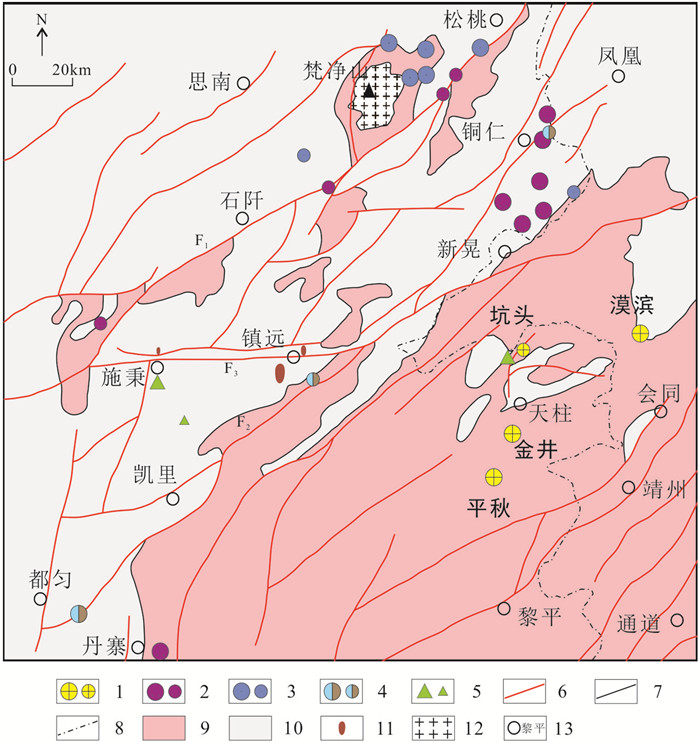
 下载:
下载:
